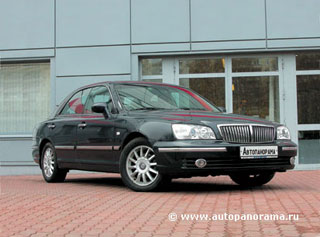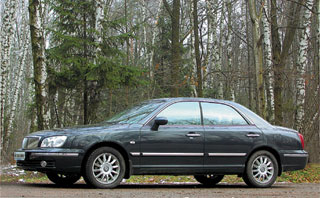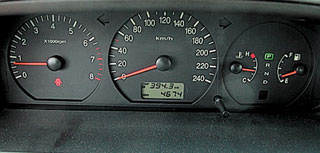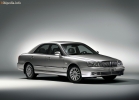Hyundai XG 2003 test drive - 2005 sedan
Hyundai XG 300

Almost certainly, the XG design task looked something like this: to develop a large front-wheel drive sedan with a V6 engine, an automatic 5-band gearbox, well equipped and at the same time relatively inexpensive. Since the main sales market of the United States, the chassis settings must comply with the standards accepted there.
 If you look at the XG 300 from these positions, then the car, undoubtedly, was a success. A spacious salon with leather seats, wood inserts, good sound insulation, many electric drives, heating seats, a set of airbags everything is in place. The salon has everything that is supposed to, and so that it also harmonizes with each other, especially no one cares. People who are accustomed to the verified design of European car interiors are unlikely to inspire the XG salon. Gray plastic of different shades in the neighborhood with inserts under a medium -sized tree, simple, if you do not call them primitive, buttons and a panel of devices, which can only be said that the driver can easily see the information he needs easily. On the other hand, there are many large sedans behind the ocean, and not only sedans, are done in about the same way, there such things are quite familiar and it does not occur to anyone to blame it.
If you look at the XG 300 from these positions, then the car, undoubtedly, was a success. A spacious salon with leather seats, wood inserts, good sound insulation, many electric drives, heating seats, a set of airbags everything is in place. The salon has everything that is supposed to, and so that it also harmonizes with each other, especially no one cares. People who are accustomed to the verified design of European car interiors are unlikely to inspire the XG salon. Gray plastic of different shades in the neighborhood with inserts under a medium -sized tree, simple, if you do not call them primitive, buttons and a panel of devices, which can only be said that the driver can easily see the information he needs easily. On the other hand, there are many large sedans behind the ocean, and not only sedans, are done in about the same way, there such things are quite familiar and it does not occur to anyone to blame it. As for external design, from afar, XG 300 can easily be accepted for the American car of the proportion of about the same. However, at a closer distance, the differences between Korean design and the American are clearly noticeable. This is the case in details. This is a drawing of the radiator lattice, and the shape of the headlights and lanterns, and the rear -view mirrors have everything, so to speak, a characteristic Asian squint. Yes, and doors without glass frames are typical primarily for Asian cars. Restyling, conducted last year, did not make any cardinal changes to the appearance of the car. The front bumper, foglights, headlight headlights and a radiator grille changed a little. The trunk lid became a little different from behind, the niche under the license plate changed, and the rear lights also changed a little. In a word, a light retouching.
 By behavior on the Hyundai XG 300 road, the most typical American without any discounts on Korean origin. The discussions about controllability, feedback on the steering wheel and other driverships are completely alien to him. It was created for a leisurely comfortable swimming on roads. The steering wheel turns almost without effort, the suspension frankly does not notice the joints and small potholes, however, on gentle waves allows the body to swing in a vertical direction. The automatic gearbox with manual switching mode works, by the way, also slowly. And even in manual mode, the effect of braking by the engine when turning on low gears is not particularly noticeable. In a word, not a driver box, but a manual mode there simply because it should be.
By behavior on the Hyundai XG 300 road, the most typical American without any discounts on Korean origin. The discussions about controllability, feedback on the steering wheel and other driverships are completely alien to him. It was created for a leisurely comfortable swimming on roads. The steering wheel turns almost without effort, the suspension frankly does not notice the joints and small potholes, however, on gentle waves allows the body to swing in a vertical direction. The automatic gearbox with manual switching mode works, by the way, also slowly. And even in manual mode, the effect of braking by the engine when turning on low gears is not particularly noticeable. In a word, not a driver box, but a manual mode there simply because it should be. So what is another American? Yes and no. Despite the fact that the approach to the creation and ideology of the car is undoubtedly American, the embodiment of everything that was clearly conceived by Asian. Let there be complaints about the design, let the behavior on the road and set up the chassis are unlikely to appeal to active drivers, but even they are unlikely to be given up the quality of assembly. All the gaps are even, nothing creaks in the cabin and does not stream, everything works without problems. And this, whatever one may say, is an argument in favor of a Korean car. Koreans clearly decided to follow the path of their Japanese neighbors, several decades ago invading the American market and entrenched in it primarily due to a good ratio of price, quality and level of equipment of their cars. What came of this, we all know. Hyundai is now actively mastering the United States. That is why XG should not be considered as an alternative to the European business class sedans, but as a rival of large and relatively inexpensive (in the overseas market) American cars. And here he may well succeed.
Some technical characteristics of the Hyundai XG 300
(manufacturer data)
Dimensions, mm: 4875x1825x1420
Base, mm: 2750
Front/behind, mm: 1540/1530
Clearance, mm: 160
Engine type: gasoline v6
Max. Power, L.S./rpm: 184/5500
Max. moment, nm/rpm: 253/3500
Transmission: automatic 5-band
Tires: 205/60 R1
Front brakes/back: disk with ABS
Top volume, l: 70
* Positions such as accelerating 0100 km/h, fuel consumption, etc., the manufacturer does not indicate.
Leonid Klimanovich







Source: Avtopanorama magazine







